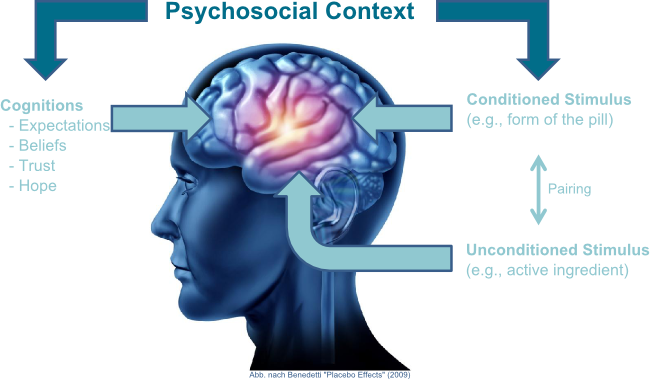Mechanisms underlying placebo effects
It has been postulated that the placebo response is mainly mediated by two distinct psychological mechanisms, expectation and conditioning. Expectation is defined as cognitions about treatment outcome, while conditioning describes the effect of former experiences in terms of associative learning. These mechanisms are frequently overlapping, but can be separated by specific experimental designs. However, the relative contribution of expectations and conditioning to placebo and nocebo effects in a given clinical or experimental condition and the interaction of these effects are largely unclear. Data in experimental pain and in Parkinson‘s disease suggest that processes such as pain and motor control are mainly affected by patients´ expectations. In contrast, biochemical processes, such as hormone release or immune functions, appear to be mediated predominantly by conditioning. However, other autonomic functions, e.g. in the gastrointestinal system, have been shown to be subject to modulation by both expectation and learning. The contribution of both effects across different physiological and psychological processes, different biological systems, and different medical conditions is far from clear.
 The psychosocial context around a medical intervention can influence the intervention’s effect through the mechanisms expectation and conditioning. The procedure of a medical intervention is surrounded by a complex psychosocial context – the presence of medical staff and the hospital’s environment, the medical terms used by doctors, the smell of drugs etc. All these context factors are hint for the procedure of a medical intervention for the patient. Therefore these context factors can influence the patient’s expectation about this medical intervention. A positive context could improve the therapeutic effect of a treatment while a negative context could reduce the effect. Further the context could have an impact on the effectiveness and result of a medical intervention through classical conditioning. After a repeated pairing of an conditioned context stimulus (e.g. the shape and color of a pill) with a unconditioned stimulus (e.g. pharmacological agent in a pill) the conditioned stimulus itself can cause the therapeutic effect (conditioned reaction). Expectation and conditioning are not mere psychological phenomenon. It can be shown that there are neurophysiological changes associated with these two mechanisms
The psychosocial context around a medical intervention can influence the intervention’s effect through the mechanisms expectation and conditioning. The procedure of a medical intervention is surrounded by a complex psychosocial context – the presence of medical staff and the hospital’s environment, the medical terms used by doctors, the smell of drugs etc. All these context factors are hint for the procedure of a medical intervention for the patient. Therefore these context factors can influence the patient’s expectation about this medical intervention. A positive context could improve the therapeutic effect of a treatment while a negative context could reduce the effect. Further the context could have an impact on the effectiveness and result of a medical intervention through classical conditioning. After a repeated pairing of an conditioned context stimulus (e.g. the shape and color of a pill) with a unconditioned stimulus (e.g. pharmacological agent in a pill) the conditioned stimulus itself can cause the therapeutic effect (conditioned reaction). Expectation and conditioning are not mere psychological phenomenon. It can be shown that there are neurophysiological changes associated with these two mechanisms








